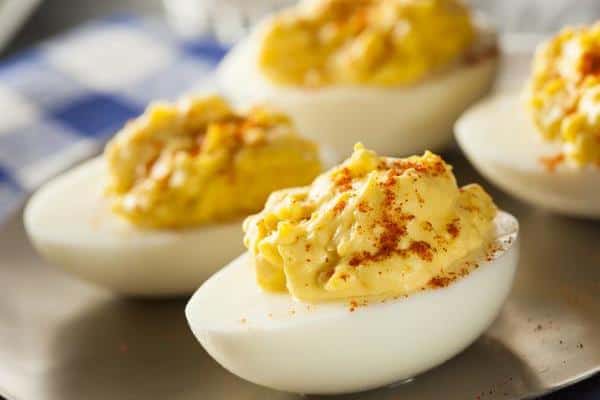This is an easy to make and extremely tasty traditional deviled eggs recipe. The creamy yolk filling makes boring hard boiled eggs a wonderful appetizer.
The Best Recipe for Deviled Eggs
This is an easy to make and extremely tasty traditional deviled eggs recipe. The creamy yolk filling makes boring hard boiled eggs a wonderful appetizer. Scroll past the recipe to get the fascinating story of where deviled eggs originated from (a long time ago in a land far a way…for real!).
Deviled Eggs Recipe
Ingredients :
6 eggs
Dash of salt
Dash of pepper
1/4 teaspoon mustard
1 1/2 to 2 1/2 Tablespoons mayonnaise
Paprika
Directions:
1. Hard boil eggs. Cool 10 minutes and remove shells. Cut into halves lengthwise and remove yolk, place yolk into a small bowl.
2. Cream yolk, salt, pepper, mustard and mayonnaise.
3. Put 1/2 teaspoonful into egg whites and garnish with paprika.
Where Deviled Eggs Came From
Deviled eggs, the beloved classic creamy concoctions did not originate in the United States. Although they weren’t prepared the same way, the roots of modern-day deviled eggs can be traced back to ancient Rome, where eggs were boiled, seasoned with spicy sauces and then typically served at the beginning of a meal—as a first course known as gustatio—for wealthy patricians. In fact, serving eggs while entertaining was so common that the Romans had a saying, “ab ova usque ad mala”—literally from eggs to apples, or from the beginning of a meal to the end. In Petronius’s satirical fiction “Satyricon,” written around 61 A.D., the wealthy freedman Trimalchio invited guests to a banquet in which the menu included fig-peckers (small songbirds) marinated in peppered egg yolk and stuffed into peahen eggs.
According to Apicius, a collection of Roman recipes believed to have been compiled sometime between the fourth and fifth century A.D., boiled eggs were traditionally seasoned with oil, wine or broth and served with pepper and laser (which was also known as silphium, a plant driven to extinction by the first century A.D.). Another recipe called for poached eggs to be dressed with soaked pine nuts, lovage (an herb of the parsley family with an anise, celery flavor), pepper, honey, vinegar and broth.
Sometime in the 13th century, stuffed eggs began to appear in Andalusia, in what is now Spain. An anonymous cookbook from this time period instructs the reader to pound boiled egg yolks with cilantro, onion juice, pepper and coriander and then beat them with murri (a sauce made of fermented barley or fish), oil and salt. After stuffing the mixture into the hollowed egg whites, the two halves were then fastened together with a small stick and peppered.
By the 15th century, stuffed eggs had made their way across much of Europe. Medieval cookbooks contain recipes for boiled eggs that were often filled with raisins, cheese and herbs such as marjoram, parsley and mint and then fried in oil and either topped with a sauce of cinnamon, ginger, cloves and raisins with verjuice (a tart juice made from unripe fruits) or powdered with sugar and served hot. In the United States, stuffed eggs began making an appearance in cookbooks by the mid-19th century.
The first known printed mention of ‘devil’ as a culinary term appeared in Great Britain in 1786, in reference to dishes including hot ingredients or those that were highly seasoned and broiled or fried. By 1800, deviling became a verb to describe the process of making food spicy. But in some parts of the world, the popular egg hors d’oeuvres are referred to as “mimosa eggs,” “stuffed eggs,” “dressed eggs” or “salad eggs”—especially when served at church functions—in order to avoid an association with Satan.
A recipe from Fannie Farmer’s 1896 “Boston Cooking-School Cookbook” was one of the earliest to suggest the use of mayonnaise as a binder for the filling. However, despite the fact that mayonnaise began to be distributed commercially in the United States in 1907, the condiment was not commonly featured in deviled egg recipes until the 1940s. The classic version of deviled eggs is now widely considered to include a mixture of mayonnaise, mustard and paprika, but professional chefs and home cooks around the world have experimented with numerous variations on the filling throughout history—including pickles, dill, bacon, crab meat, sriracha, kimchi, wasabi and caviar among many others.
